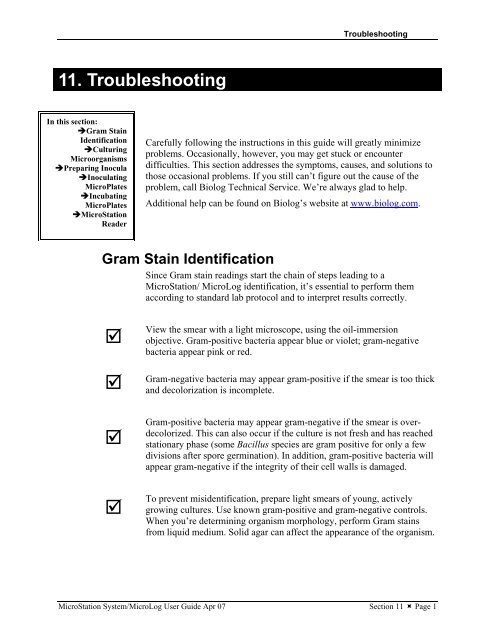MicroStation System, MicroLog Version 4.2 - DTU Systems Biology ...
MicroStation System, MicroLog Version 4.2 - DTU Systems Biology ...
MicroStation System, MicroLog Version 4.2 - DTU Systems Biology ...
Create successful ePaper yourself
Turn your PDF publications into a flip-book with our unique Google optimized e-Paper software.
11. Troubleshooting<br />
In this section:<br />
�Gram Stain<br />
Identification<br />
�Culturing<br />
Microorganisms<br />
�Preparing Inocula<br />
�Inoculating<br />
MicroPlates<br />
�Incubating<br />
MicroPlates<br />
�<strong>MicroStation</strong><br />
Reader<br />
Troubleshooting<br />
Carefully following the instructions in this guide will greatly minimize<br />
problems. Occasionally, however, you may get stuck or encounter<br />
difficulties. This section addresses the symptoms, causes, and solutions to<br />
those occasional problems. If you still can’t figure out the cause of the<br />
problem, call Biolog Technical Service. We’re always glad to help.<br />
Additional help can be found on Biolog’s website at www.biolog.com.<br />
Gram Stain Identification<br />
Since Gram stain readings start the chain of steps leading to a<br />
<strong>MicroStation</strong>/ <strong>MicroLog</strong> identification, it’s essential to perform them<br />
according to standard lab protocol and to interpret results correctly.<br />
�<br />
�<br />
�<br />
�<br />
View the smear with a light microscope, using the oil-immersion<br />
objective. Gram-positive bacteria appear blue or violet; gram-negative<br />
bacteria appear pink or red.<br />
Gram-negative bacteria may appear gram-positive if the smear is too thick<br />
and decolorization is incomplete.<br />
Gram-positive bacteria may appear gram-negative if the smear is overdecolorized.<br />
This can also occur if the culture is not fresh and has reached<br />
stationary phase (some Bacillus species are gram positive for only a few<br />
divisions after spore germination). In addition, gram-positive bacteria will<br />
appear gram-negative if the integrity of their cell walls is damaged.<br />
To prevent misidentification, prepare light smears of young, actively<br />
growing cultures. Use known gram-positive and gram-negative controls.<br />
When you’re determining organism morphology, perform Gram stains<br />
from liquid medium. Solid agar can affect the appearance of the organism.<br />
<strong>MicroStation</strong> <strong>System</strong>/<strong>MicroLog</strong> User Guide Apr 07 Section 11 � Page 1


